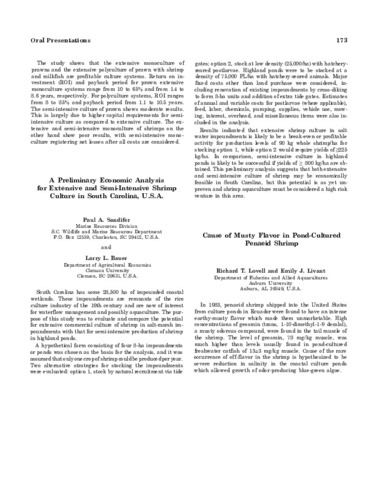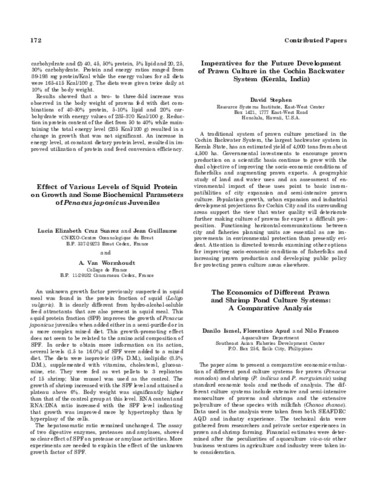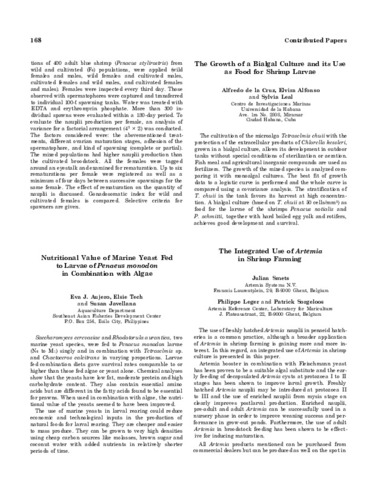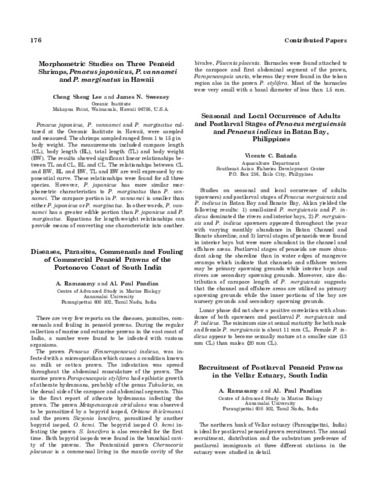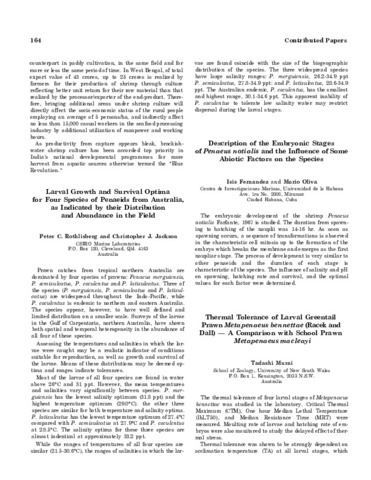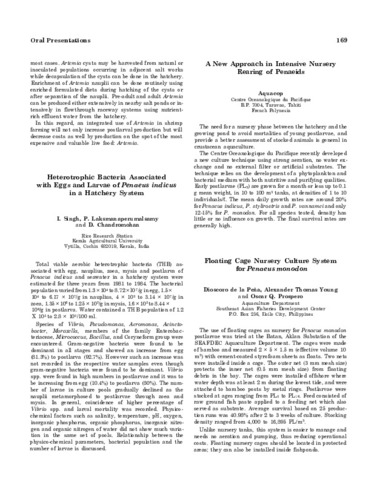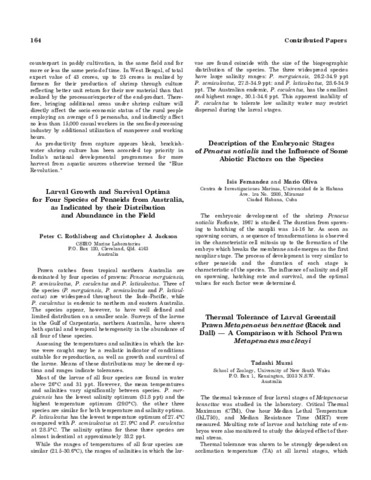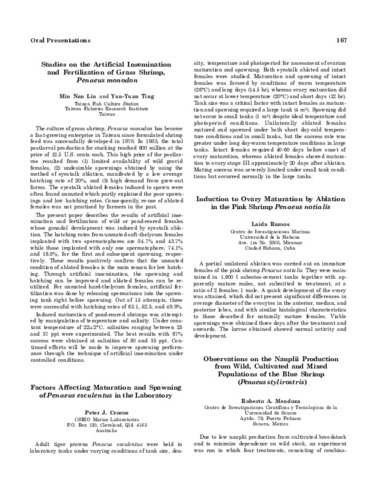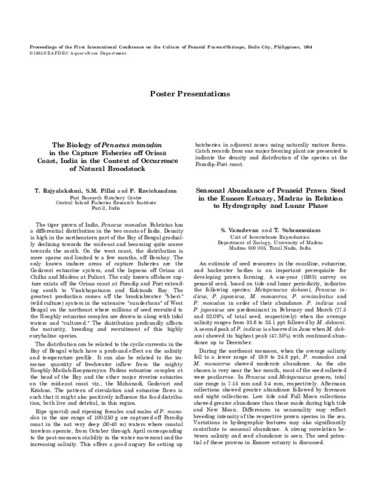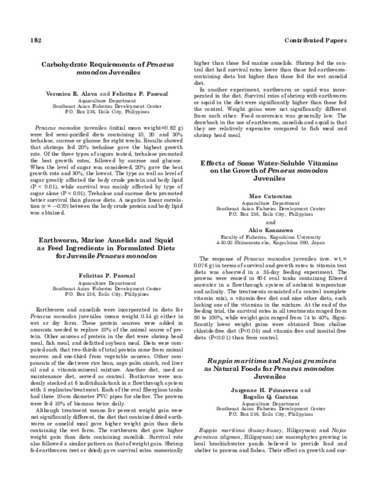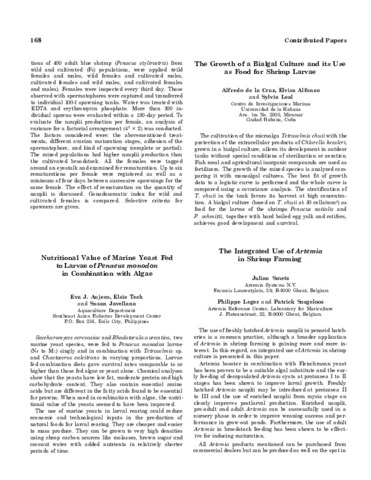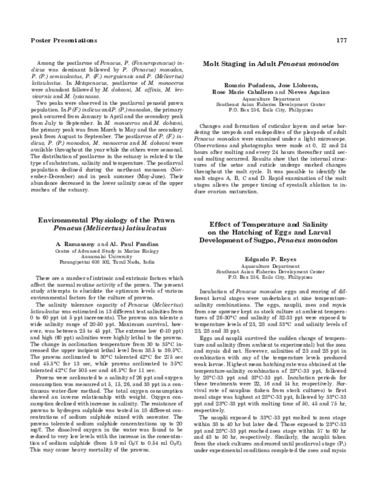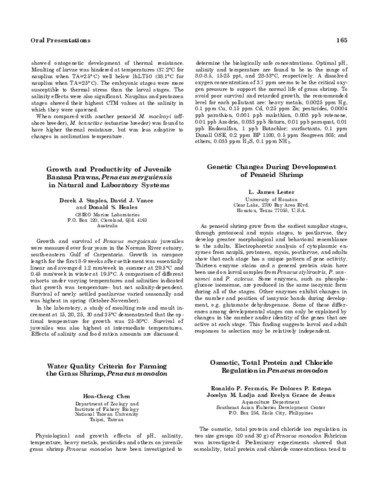Browsing Proceedings of the First International Conference on the Culture of Penaeid Prawns/Shrimps by Issue Date
Now showing items 1-20 of 79
-
Cause of musty flavor in pond-cultured penaeid shrimp
(Aquaculture Department, Southeast Asian Fisheries Development Center, 1985)In 1983, penaeid shrimp shipped into the United States from culture ponds in Ecuador were found to have an intense earthy-musty flavor which made them unmarketable. High concentrations of geosmin (trans, 1-10-dimethyl-1-9 ... -
Effect of various levels of squid protein on growth and some biochemical parameters of Penaeus japonicus juveniles
(Aquaculture Department, Southeast Asian Fisheries Development Center, 1985)An unknown growth factor previously suspected in squid meal was found in the protein fraction of squid (Loligo vulgaris). It is clearly different from hydro-alcohol-soluble feed attractants that are also present in squid ... -
A preliminary economic analysis for extensive and semi-intensive shrimp culture in South Carolina, U.S.A.
(Aquaculture Department, Southeast Asian Fisheries Development Center, 1985)South Carolina has some 28,500 ha of impounded coastal wetlands. These impoundments are remnants of the rice culture industry of the 19th century and are now of interest for waterflow management and possibly aquaculture. ... -
The production economics of an integrated prawn hatchery-floating nursery project
(Aquaculture Department, Southeast Asian Fisheries Development Center, 1985)The paper aims to present an economic evaluation of an integrated prawn (Penaeus monodon) hatchery-floating nursery project using standard economic tools and methods of analysis. The data used in the analysis were taken ... -
Nutritional value of marine yeast fed to larvae of Penaeus monodon in combination with algae
(Aquaculture Department, Southeast Asian Fisheries Development Center, 1985)Saccharomyces cerevasiae and Rhodotorula aurantica, two marine yeast species, were fed to Penaeus monodon larvae (N6 to M1) singly and in combination with Tetraselmis sp. and Chaetoceros calcitrans in varying proportions. ... -
Recruitment of postlarval penaeid prawns in the Vellar estuary, South India
(Aquaculture Department, Southeast Asian Fisheries Development Center, 1985)The northern bank of Vellar estuary (Parangipettai, India) is ideal for postlarval penaeid prawn recruitment. The annual recruitment, distribution and the substratum preference of postlarval immigrants at three different ... -
Thermal tolerance of larval greentail prawn Metapenaeus bennettae (Raced and Dall) a comparison with school prawn Metapenaeus macleayi
(Aquaculture Department, Southeast Asian Fisheries Development Center, 1985)The thermal tolerance of four larval stages of Metapenaeus bennettae was studied in the laboratory. Critical Thermal Maximum (CTM), One hour Median Lethal Temperature (lhLT50), and Median Resistance Time (MRT) were measured. ... -
A new approach in intensive nursery rearing of penaeids
(Aquaculture Department, Southeast Asian Fisheries Development Center, 1985)The need for a nursery phase between the hatchery and the growing pond to avoid mortalities of young postlarvae, and provide a better assessment of stocked animals is general in crustacean aquaculture. The Centre ... -
Description of the embryonic stages of Penaeus notialis and the influence of some abiotic factors on the species
(Aquaculture Department, Southeast Asian Fisheries Development Center, 1985)The embryonic development of the shrimp Penaeus notialis Farfante, 1967 is studied. The duration from spawning to hatching of the nauplii was 14-16 hr. As soon as spawning occurs, a sequence of transformations is observed ... -
Induction to ovary maturation by ablation in the pink shrimp Penaeus notialis
(Aquaculture Department, Southeast Asian Fisheries Development Center, 1985)A partial unilateral ablation was carried out on immature females of the pink shrimp Penaeus notialis. They were maintained in 1,600 ℓ asbestos-cement tanks together with apparently mature males, not submitted to ... -
Economics of penaeid culture in the Americas
(Aquaculture Department, Southeast Asian Fisheries Development Center, 1985)Shrimp culture in the Americas began in the early 1970's and has experienced rapid growth in some Latin American countries. Currently, Latin America produces one-third of all cultured shrimp with Ecuador as the leading ... -
Seasonal abundance of Penaeid prawn seed in the Ennore estuary, Madras in relation to hydrography and lunar phase
(Aquaculture Department, Southeast Asian Fisheries Development Center, 1985)An estimate of seed resources in the coastline, estuarine, and backwater bodies is an important prerequisite for developing prawn farming. A one-year (1983) survey on penaeid seed, based on tide and lunar periodicity, ... -
A brief review of the larval rearing techniques of penaeid prawns
(Aquaculture Department, Southeast Asian Fisheries Development Center, 1985)As early as half a century ago, Hudinaga successfully spawned and attempted to rear the larvae of Penaeus japonicus. Publications in the 1960 s, 70's and 80's on breakthroughs in larval rearing of one penaeid species after ... -
Earthworm, marine annelids and squid as feed ingredients in formulated diets for juvenile Penaeus monodon
(Aquaculture Department, Southeast Asian Fisheries Development Center, 1985)Earthworm and annelids were incorporated in diets for Penaeus monodon juveniles (mean weight 0.54 g) either in wet or dry form. These protein sources were added in amounts needed to replace 10% of the animal source of ... -
The integrated use of artemia in shrimp farming
(Aquaculture Department, Southeast Asian Fisheries Development Center, 1985)The use of freshly hatched Artemia nauplii in penaeid hatcheries is a common practice, although a broader application of Artemia in shrimp farming is gaining more and more interest. In this regard, an integrated use of ... -
The growth of a bialgal culture and its use as food for shrimp larvae
(Aquaculture Department, Southeast Asian Fisheries Development Center, 1985)The cultivation of the microalga Tetraselmis chuii with the protection of the extracellular products of Chlorella kessleri, grown in a bialgal culture, allows its development in outdoor tanks without special conditions of ... -
Imperatives for the future development of prawn culture in the Cochin backwater system (Kerala, India)
(Aquaculture Department, Southeast Asian Fisheries Development Center, 1985)A traditional system of prawn culture practised in the Cochin Backwater System, the largest backwater system in Kerala State, has an estimated yield of 4,000 tons from about 4,500 ha. Governmental investments to encourage ... -
Molt staging in adult Penaeus monodon
(Aquaculture Department, Southeast Asian Fisheries Development Center, 1985)Changes and formation of cuticular layers and setae bordering the uropods and endopodites of the pleopods of adult Penaeus monodon were examined under a light microscope. Observations and photographs were made at 0, 12 and ... -
Genetic changes during development of penaeid shrimp
(Aquaculture Department, Southeast Asian Fisheries Development Center, 1985)As penaeid shrimp grow from the earliest naupliar stages, through protozoeal and mysis stages, to postlarvae, they develop greater morphological and behavioral resemblance to the adults. Electrophoretic analysis of cytoplasmic ... -
Variation in tissue lipid content and fatty acid composition during ovarian maturation of unablated and ablated Penaeus monodon broodstock
(Aquaculture Department, Southeast Asian Fisheries Development Center, 1985)The tissue lipid content and fatty acid composition in the hepatopancreas, tail muscle and gonad of unablated and ablated Penaeus monodon were determined. Females at various stages of maturity were collected from offshore ...

